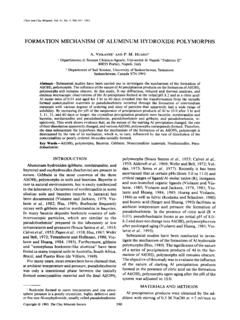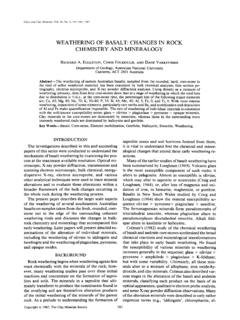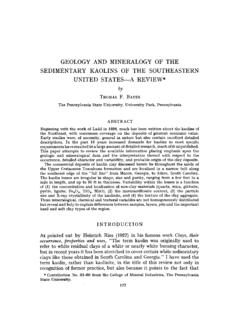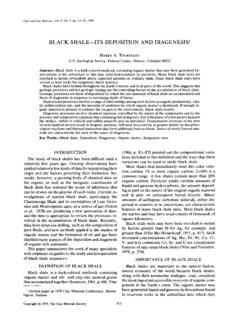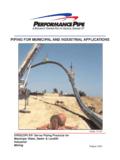Transcription of INDUSTRIAL APPLICATIONS OF BENTONITE by
1 INDUSTRIAL APPLICATIONS OF BENTONITE by ARTHUR G. CLElYI ANn ROBERT W. DOEHLER American Colloid Company, Skokie, Illinois ABSTRACT BENTONITE is employed by industry to perform a multitude of jobs. Certain INDUSTRIAL APPLICATIONS become apparent from an understanding of the composition and structure of BENTONITE , and the properties they create. These properties are utilized chiefly when the material is suspended in a liquid, usually water; or as a dried powder or granule. Most INDUSTRIAL APPLICATIONS involve the swelling property of BENTONITE to form viscous water suspensions. Depending upon the relative proportions of clay and water, these mixtures are used as bonding, plasticizing, and suspending agents. Bentonites disperse into colloidal particles and, accordingly, provide large surface areas per unit weight of clay. This large surface area is a major reason why BENTONITE functions so well in stabilizing emulsions, or as a medium to carry other chemicals.
2 Bentonites react chemically with many organic materials to form compounds which are used chiefly as gelling agents in a variety of organic liquids. Bentonites are selected for each INDUSTRIAL need on the basis of type and quality. This selection is based principally on physical properties, and chemistry of the BENTONITE becomes involved only to the extent that it influences the physical properties. INTRODUCTION Although the BENTONITE industry is slight]y over 70 years old, the name BENTONITE was applied as e~rly as 1848 by Knight to a highly plastic clay material occurring near Fort Benton, Wyoming (Grim, 1953, p. 361). Accord- ing to Chisholm (1960, p. 30) the first commercial BENTONITE was shipped in 1888 under the name "Taylorite". From this modest beginning, in which production amounted to only a few tons per year, BENTONITE production now exceeds a million tons per year (Table 1).
3 In fact, average annual production over the past 10 years has exceeded 1~ million tons; 1956 was the highest production year with more than 1 89 million tons ( Bureau of Mines Minerals Yearboo]~s, 1939-1960). The BENTONITE industry began initially in Wyoming and South Dakota, but today Mississippi and Texas both contribute substantial tonnage to the yearly production figure. The origin of BENTONITE is ~ttributed to the alteration of volcanic ash, or glass, but common use of the term is often extended to include material of primarily a montmorillonite composition which may have formed in another manner. 272 INDUSTRIAL APPLICATIONS OF ]~ENTONITE 273 O D~ O o 9 i ~ ~~ ~~ ~Z~ ~~ ~o~o o o q~ o :S ~ o 18 274 TENTH NATIONAL CONFEI~ENCE ON CLAYS AND CLAY MINERALS Bcntonites are typically strip-mined, that is, the overburden is removed initially in order to expose the BENTONITE .
4 The clay normally occurs as lenses which are a few feet thick. After mining, the BENTONITE is generally stockpiled, dried, separated with respect to particle size or ground to a powder, bagged, and shipped. BENTONITE COMPOSITION AND PROPERTIES It is desirable at this point to understand the nature of BENTONITE . Various definitions of BENTONITE have been given in the literature, but generally all agree that BENTONITE is a rock term used to designate a naturally occurring, (A) C) A,~,~ (.-)= HYDROXYLS (B) ALUHI NUHS,HAGNESI UHS ETC. FlaVRE sketch showing (A) single oetahedrM unit, and (B) portion of an octahedral sheet structure. (A) (a) (~ A,~O ~'~)= OXYGENS C) AND O: SILICONS Fmua~ sketch showing (A) single silica tetrahedron, and (B) portion of a silica tetrahedral sheet structure. very fine grained material largely composed of the clay mineral, montmorillo- nite.
5 Accordingly, a description and discussion of montmorillonite is applic- able to BENTONITE as well. BENTONITE , in addition to montmorillonite, contains a small portion of other mineral matter, usually quartz, feldspar, volcanic glass, organic matter, gypsum, or pyrite. Chemically, montmorillonite is described as a hydrous aluminum silicate containing small amounts of alkali and alkaline+arth metals. Structurally, montmorillonite is made of two basic building blocks, the aluminum octa- hedral sheet and the silica tctrahedral sheet (Figs. 1 and 2). A single mont- morillonitc unit cell consists of two silica tetrahedral sheets, between which INDUSTRIAL APPLICATIONS OF BENTONITE 275 is an aluminum octahedral sheet (Fig. 3). Lengths and widths of montmorillo- nite flakes are from 10 to 100 times the thicknesses. The montmorillonite lattice is negative in charge, owing primarily to isomorphous replacements of ions within the structure.
6 This negative character is balanced by cations which are held on the surface of the flakes. Cations held in this fashion by the clay can be readily exchanged; the cations most commonly found in nature are sodium and calcium. \\ I ~/ "~\ /0/ \,~ OCTAHEDRAL .. EXCHANGEABLE CATIONS nH20 O OXYGENS ~) HYDROXYLS 0 ALUMINUM, IRON, MAGNESIUM 0 AMO @ sILICON, OCCASIONALLY ALUMINUM FIGURE skeYGch of the structure of montmorillonite (after Grim, 1953). Montmorillonite has a cation-exchange capacity of about 70 to 110 meq/ 100 g of clay. Generally the laws of mass action dictate which will be present as exchangeable ions on the clay. The exchangeable cations, both by type and amount, that are associated with the montmorillonite are of great importance since they largely control its physical properties. Montmorillonite adsorbs water whenever it is available.
7 Water adsorption occurs to the greatest extent on the basal surfaces of the clay and in this fashion pries adjacent flakes apart, resulting in an overall volume increase of the clay. Evidence of this swelling mechanism is seen as an increase in the c-axis dimension of the clay (Fig. 4). The water which is adsorbed primarily on the basal surfaces of the clay (frequently referred to as "bound" or 276 TENTH I~ATIONAL CONFERENCE ON CLAYS AND CLAY MINERALS "oriented" water) consists of a regular, rather than a random, arrangement of water molecules; the energy with which the water orients and is bonded to the clay flake is measured as heat of wetting. Many types of organic materials are adsorbed by montmorillonite, and this adsorption is somewhat similar in manner and orientation to that of water. Organic material adsorbed on basal surfaces also increases the c-axis MOISTURE FREE ~L o o o " LOW" MOISTURE ti ~ "HIGH" MOISTURE o H20 o o I -- I ~, o o ~ EXCHANGE CATIONS YI I FIGURE sketch which shows swelling action of montmorillonite with increasing moisture content.
8 Dimension of the clay. Some of the parameters governing organic adsorption include type and composition of the organic material, the organic concentra- tion, ptt, and the presence or absence of water in the system. INDUSTRIALLY ATTRACTIVE PROPERTIES OF BENTONITE The greatest use of BENTONITE in industry results from its swelling action in water. Combinations of water and BENTONITE can perform a multitude of jobs in industry because physical properties of the mixtures change as the water- to-clay ratio changes. The swelling capacity of the clay is of prime importance: this property is controlled in large part by the types of associated exchange ions. Let us consider only the two most common montmorillonite varieties. The sodium bentonites expand or swell in aqueous suspensions more than the calcium. At relatively low moisture contents, a stable hydrated form of sodium montmorillonite has one adsorbed molecular layer of water between adjacent layers.
9 At this same moisture content, calcium montmorillonite is stable with two molecular layers of water. At higher moisture contents, or even in suspension, a comparison of the calcium and sodium montmorillonites shows that the calcium variety has fewer, more tightly bound water layers ~NDUSTRIAL APPLICATIONS OF BENTONITE 277 associated with it, whereas the sodium variety has many water layers, but bound less tightly. When a relatively small amount of water is mixed with a large amount of BENTONITE , the mixture forms a sticky mass which has adhesive properties. This physical state results when the water content is inadequate to fulfill the oriented water requirement by the montmorillonite. The plastic properties of a clay-water system increase as the ratio of water to clay increases. When each montmorillonite flake has adsorbed its maximum amount of water, additional water in the system acts as a lubricant for the hydrated particles.
10 It frequently takes a period of time or ageing for the clay to develop a com- pletely hydrated state, even if the necessary water is available. Aggregates of clay flakes are disaggregated by agitation or stirring in suspension, and this substantially aids the clay swelling or hydration. Usually, however, swelling proceeds with additional time as water pries its way between neighboring clay flakes which agitation has been unable to separate. When BENTONITE disaggregates in water and swelling takes place, the average clay particle size decreases. As a function of decreasing particle size, the number of particles per unit weight of clay increases, and consequently also the available surface area. Grim (1953, p. 311) states that a theoretical value for the surface area of sodium montmorillonite, disaggregated to unit cell dimensions, is of the order of 800 m~/g of clay.

